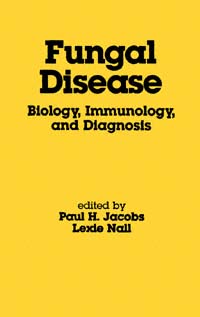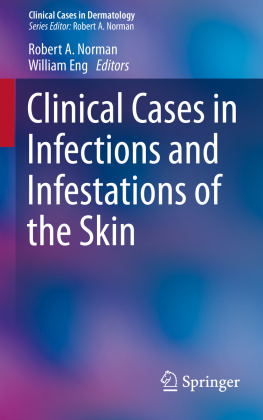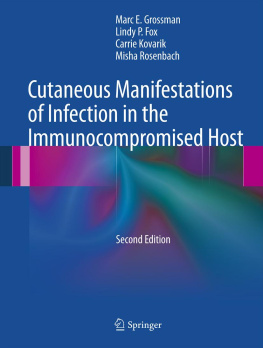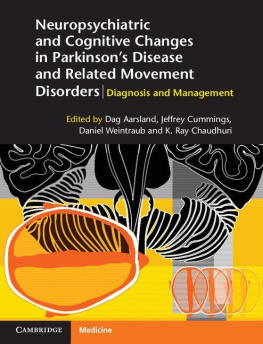Cover

| title | : | Fungal Disease : Biology, Immunology, and Diagnosis Basic and Clinical Dermatology ; 12 |
| author | : | Jacobs, Paul H. |
| publisher | : | Informa Healthcare |
| isbn10 | asin | : | 0824794028 |
| print isbn13 | : | 9780824794026 |
| ebook isbn13 | : | 9780585381114 |
| language | : | English |
| subject | Mycoses, Mycoses--Immunological aspects, Mycoses--Diagnosis, Mycoses--immunology, Mycoses--drug therapy, Antifungal Agents--therapeutic use, Fungi--pathogenicity. |
| publication date | : | 1997 |
| lcc | : | QR245.F853 1997eb |
| ddc | : | 616.9/69 |
| subject | : | Mycoses, Mycoses--Immunological aspects, Mycoses--Diagnosis, Mycoses--immunology, Mycoses--drug therapy, Antifungal Agents--therapeutic use, Fungi--pathogenicity. |
Page null03
FungalDisease
Page null04
BASIC AND CLINICAL DERMATOLOGY
Series Editors
ALAN R. SHALITA, M.D.
Professor and Chairman
Department of Dermatology
State University of New York
Health Science Center at Brooklyn
Brooklyn, New York
DAVID A. NORRIS, M.D.
Director of Research
Professor of Dermatology
The University of Colorado
Health Sciences Center
Denver, Colorado
1. Cutaneous Investigation in Health and Disease: Noninvasive Methodsand Instrumentation, edited by Jean-Luc Lvque
2. Irritant Contact Dermatitis, edited by Edward M. Jackson and RonaldGoldner
3. Fundamentals of Dermatology: A Study Guide, Franklin S. Glickmanand Alan R. Shalita
4. Aging Skin: Properties and Functional Changes, edited by Jean-LucLvque and Pierre G. Agache
5. Retinoids: Progress in Research and Clinical Applications, edited byMaria A. Livrea and Lester Packer
6. Clinical Photomedicine, edited by Henry W. Lim and Nicholas A. Soter
7. Cutaneous Antifungal Agents: Selected Compounds in Clinical Practice and Development, edited by John W. Rippon and Robert A.Fromtling
8. Oxidative Stress in Dermatology, edited by Jrgen Fuchs and LesterPacker
9. Connective Tissue Diseases of the Skin, edited by Charles M. Lapireand Thomas Krieg
10. Epidermal Growth Factors and Cytokines, edited by Thomas A. Lugerand Thomas Schwarz
11. Skin Changes and Diseases in Pregnancy, edited by Marwali Harahapand Robert C. Wallach
12. Fungal Disease: Biology, Immunology, and Diagnosis, edited by PaulH. Jacobs and Lexie Nall
ADDITIONAL VOLUMES IN PREPARATION
Page i
FungalDisease
Biology, Immunology,and Diagnosis
edited by
Paul H. Jacobs
Lexie Nall
Stanford University School of Medicine
Stanford, California

Page ii
Library of Congress Cataloging-in-Publication Data
Fungal disease: biology, immunology, and diagnosis / edited by Paul
H. Jacobs, Lexie Nall.
p. cm. Basic and clinical dermatology; 12)
Includes bibliographical references and index.
ISBN 0-8247-9402-8 (alk. paper)
1. Mycoses. 2. MycosesImmunological aspects. 3. Mycoses
-Diagnosis. I. Jacobs, Paul H. II. Nall, Lexie.III. Series.
[DNLM: 1. Mycosesimmunology. 2. Mycosesdrug therapy.3. Antifungal Agentstherapeutic use. 4. Fungipathogenicity.
W1 CL69L v.12 1997 / WC 450 F9788 1997]
QR245.F853 1997
616.9'69dc20
DNLM/DLC
for Library of Congress
96-18673
CIP
The publisher offers discounts on this book when ordered in bulk quantities. For more information, write to Special Sales/Professional Marketingat the address below.
This book is printed on acid-free paper.
Copyright 1997 by MARCEL DEKKER, INC. All Rights Reserved .
Neither this book nor any part may be reproduced or transmitted in anyform or by any means, electronic or mechanical, including photocopying,microfilming, and recording, or by any information storage and retrievalsystem, without permission in writing from the publisher.
MARCEL DEKKER, INC.
270 Madison Avenue, New York, New York 10016
Current printing (last digit):
10 9 8 7 6 5 4 3 2 1
PRINTED IN THE UNITED STATES OF AMERICA
Page iii
Preface
This text consists of chapters written by world renowned researchers andclinicians. Its purpose is to present to the reader the pertinent basic science studies in a common-sense, practical manner for the clinician, whotoday is faced with an exponential increase in fungal infections in theimmunocompromised patient, the elderly, and the ever-increasing AIDSpopulation. It presents the latest in state-of-the-art data in clinical mycology for the practitioner and indicates areas for future investigations andtherapies.
We briefly describe many of the chapters in the book to indicate thebroad range of material: Dr. Borgers covers in detail the ultrastructure offungi with his unequaled electron microscopy work. Cell-mediated immunity is simplified by Dr. Cassone, while Dr. Hay covers immunology, andDr. Hearn, the structure and function of the fungal cell wall. Dr. Niliusstresses the importance of iron acquisition in aspergillosis, Dr. Odds records the methodology of strain typing of Candida , and Dr. Domer spellsout immunomodulation by Candida . Dr. Segal gives the basis for Candida adherence and penetration. Fungal enzymes and their relationship to pathogenesis are documented by Dr. Ogawa. Dr. Richardson's article is relatedto neutrophils in cryptococcal infections, and Dr. Ruiz-Herrera's, to thebiology of mucoralis agents. Discussion of immune and clinical responsesto paracoccidioid organisms is the contribution by Drs. San-Blas and San-Blas.
Page iv
Dr. Seeliger presents insight into the pathogenesis of Aspergillus , andDr. Steele, into the proteinase gene identification of the organism. Dr.Takahashi's treatise covers fungicidal activity in tissue, and Dr. VandenBossche's explains the determinants of polymorphism. Dr. Wagner delineates the mechanisms of cutaneous defense. And the significant breakthrough that at last has occurred in the treatment of onychomycosis isthoroughly documented by Dr. De Donker. Drs. Korting and Braun-Falcounderscore the important treatment adjunct through the use of liposomes.And Dr. Wheat discusses susceptibility to histoplasmosis.
Are Pityrosporum orbiculare and ovale the same organism? Dr. Faergemann offers his views.
Taxonomy is included in Dr. McGinnis's study. Dr. Polonelli reviewsvaccine development and use. Dr. Sigler acquaints us with some of thelesser known fungi that may cause problems in the future, and Dr. VanCutsem covers animal models. Azole drug resistance in Candida is Dr.Warnock's study, while Dr. Iwata explains the mechanism of azole resistance. And although systemic allylamines are not yet approved in theUnited States, Dr. Elewski informs us of their application in other countries.
Next page







